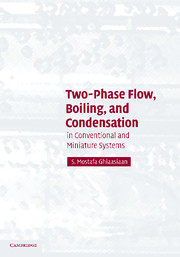Book contents
- Frontmatter
- Contents
- Preface
- Frequently Used Notation
- TWO-PHASE FLOW, BOILING AND CONDENSATION IN CONVENTIONAL AND MINIATURE SYSTEMS
- PART ONE TWO-PHASE FLOW
- 1 Thermodynamic and Single-Phase Flow Fundamentals
- 2 Gas–Liquid Interfacial Phenomena
- 3 Two-Phase Mixtures, Fluid Dispersions, and Liquid Films
- 4 Two-Phase Flow Regimes – I
- 5 Two-Phase Flow Modeling
- 6 The Drift Flux Model and Void–Quality Relations
- 7 Two-Phase Flow Regimes – II
- 8 Pressure Drop in Two-Phase Flow
- 9 Countercurrent Flow Limitation
- 10 Two-Phase Flow in Small Flow Passages
- PART TWO BOILING AND CONDENSATION
- APPENDIX A Thermodynamic Properties of Saturated Water and Steam
- APPENDIX B Transport Properties of Saturated Water and Steam
- APPENDIX C Thermodynamic Properties of Saturated Liquid and Vapor for Selected Refrigerants
- APPENDIX D Properties of Selected Ideal Gases at 1 Atmosphere
- APPENDIX E Binary Diffusion Coefficients of Selected Gases in Air at 1 Atmosphere
- APPENDIX F Henry's Constant of Dilute Aqueous Solutions of Selected Substances at Moderate Pressures
- APPENDIX G Diffusion Coefficients of Selected Substances in Water at Infinite Dilution at 25°C
- APPENDIX H Lennard–Jones Potential Model Constants for Selected Molecules
- APPENDIX I Collision Integrates for the Lennard–Jones Potential Model
- APPENDIX J Physical Constants
- APPENDIX K Unit Conversions
- References
- Index
9 - Countercurrent Flow Limitation
- Frontmatter
- Contents
- Preface
- Frequently Used Notation
- TWO-PHASE FLOW, BOILING AND CONDENSATION IN CONVENTIONAL AND MINIATURE SYSTEMS
- PART ONE TWO-PHASE FLOW
- 1 Thermodynamic and Single-Phase Flow Fundamentals
- 2 Gas–Liquid Interfacial Phenomena
- 3 Two-Phase Mixtures, Fluid Dispersions, and Liquid Films
- 4 Two-Phase Flow Regimes – I
- 5 Two-Phase Flow Modeling
- 6 The Drift Flux Model and Void–Quality Relations
- 7 Two-Phase Flow Regimes – II
- 8 Pressure Drop in Two-Phase Flow
- 9 Countercurrent Flow Limitation
- 10 Two-Phase Flow in Small Flow Passages
- PART TWO BOILING AND CONDENSATION
- APPENDIX A Thermodynamic Properties of Saturated Water and Steam
- APPENDIX B Transport Properties of Saturated Water and Steam
- APPENDIX C Thermodynamic Properties of Saturated Liquid and Vapor for Selected Refrigerants
- APPENDIX D Properties of Selected Ideal Gases at 1 Atmosphere
- APPENDIX E Binary Diffusion Coefficients of Selected Gases in Air at 1 Atmosphere
- APPENDIX F Henry's Constant of Dilute Aqueous Solutions of Selected Substances at Moderate Pressures
- APPENDIX G Diffusion Coefficients of Selected Substances in Water at Infinite Dilution at 25°C
- APPENDIX H Lennard–Jones Potential Model Constants for Selected Molecules
- APPENDIX I Collision Integrates for the Lennard–Jones Potential Model
- APPENDIX J Physical Constants
- APPENDIX K Unit Conversions
- References
- Index
Summary
General Description
Countercurrent flow limitation (CCFL), or flooding, refers to an important class of gravity-induced hydrodynamic processes that impose a serious restriction on the operation of gas–liquid two-phase systems. Some examples in which CCFL is among the factors that determine what we can and cannot be done are the following:
a) the emergency coolant injection into nuclear reactor cores following loss of coolant accidents,
b) the “reflux” phenomenon in vertically oriented condenser channels with bottom-up vapor flow, and
c) transport of gas–liquid fossil fuel mixtures in pipelines.
In the first example the coolant liquid attempts to penetrate the overheated system by gravity while vapor that results from evaporation attempts to rise, leading to a countercurrent flow configuration. The rising vapor can seriously reduce the rate of liquid penetration, or even completely block it. In the third example, the occurrence of CCFL causes a significant increase in the pressure drop and therefore the needed pumping power. CCFL represents a major issue that must be considered in the design and analysis of any system where a countercurrent of a gas and a liquid takes place.
To better understand the CCFL process, let us consider the simple experiment displayed in Fig. 9.1, where a large and open tank or plenum that contains a liquid is connected to a vertical pipe at its bottom. The vertical pipe itself is connected to a mixer before it drains into the atmosphere. Air can be injected into the mixer via the gas injection line.
- Type
- Chapter
- Information
- Two-Phase Flow, Boiling, and CondensationIn Conventional and Miniature Systems, pp. 228 - 244Publisher: Cambridge University PressPrint publication year: 2007



